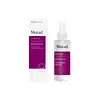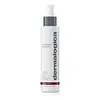What's inside
What's inside
 Key Ingredients
Key Ingredients

 Benefits
Benefits

 Concerns
Concerns

 Ingredients Side-by-side
Ingredients Side-by-side

Water
Skin ConditioningButylene Glycol
HumectantHamamelis Virginiana Water
AstringentUrea
BufferingYeast Amino Acids
HumectantTrehalose
HumectantInositol
HumectantTaurine
BufferingBetaine
HumectantChondrus Crispus Extract
Skin ConditioningPrunus Persica Fruit Extract
AbrasiveAnthemis Nobilis Flower Extract
MaskingSodium PCA
HumectantLecithin
EmollientTocopherol
AntioxidantMagnesium Ascorbyl Phosphate
AntioxidantVitis Vinifera Seed Extract
AntimicrobialGlycerin
HumectantCucumis Sativus Fruit Extract
EmollientPEG-12 Dimethicone
Skin ConditioningPEG-40 Hydrogenated Castor Oil
EmulsifyingSodium Citrate
BufferingDisodium EDTA
Phenoxyethanol
PreservativeCaprylyl Glycol
EmollientChlorphenesin
AntimicrobialSodium Benzoate
MaskingBenzyl Salicylate
PerfumingGeraniol
PerfumingLinalool
PerfumingCitronellol
PerfumingParfum
MaskingCI 15510
Cosmetic ColorantCI 14700
Cosmetic ColorantWater, Butylene Glycol, Hamamelis Virginiana Water, Urea, Yeast Amino Acids, Trehalose, Inositol, Taurine, Betaine, Chondrus Crispus Extract, Prunus Persica Fruit Extract, Anthemis Nobilis Flower Extract, Sodium PCA, Lecithin, Tocopherol, Magnesium Ascorbyl Phosphate, Vitis Vinifera Seed Extract, Glycerin, Cucumis Sativus Fruit Extract, PEG-12 Dimethicone, PEG-40 Hydrogenated Castor Oil, Sodium Citrate, Disodium EDTA, Phenoxyethanol, Caprylyl Glycol, Chlorphenesin, Sodium Benzoate, Benzyl Salicylate, Geraniol, Linalool, Citronellol, Parfum, CI 15510, CI 14700
Water
Skin ConditioningButylene Glycol
HumectantPEG-40
HumectantHydrogenated Castor Oil
EmollientArginine/Lysine Polypeptide
Skin ConditioningAloe Barbadensis Leaf Juice
Skin ConditioningSodium Lactate
BufferingSodium PCA
HumectantSorbitol
HumectantProline
Skin ConditioningDipotassium Glycyrrhizate
HumectantMethyl Gluceth-20
HumectantCamellia Sinensis Leaf Extract
AntimicrobialSodium Carboxymethyl Beta-Glucan
CleansingLecithin
EmollientMagnesium Ascorbyl Phosphate
AntioxidantTocopherol
AntioxidantPalmitoyl Tripeptide-5
Skin ConditioningBambusa Vulgaris Leaf/Stem Extract
HumectantRose Flower Oil
MaskingPisum Sativum Extract
Skin ConditioningCupressus Sempervirens Leaf Oil
MaskingCymbopogon Martini Oil
MaskingGlucosamine Hcl
Cymbopogon Schoenanthus Oil
MaskingGlycerin
HumectantEucalyptus Globulus Leaf Oil
PerfumingDisodium EDTA
Caprylic/Capric Triglyceride
MaskingCitrus Limon Peel Extract
EmollientHelianthus Annuus Seed Oil
EmollientRosa Damascena Flower Oil
MaskingEugenia Caryophyllus Flower Oil
MaskingAniba Rosodora Wood Oil
AstringentCitrus Limon Peel Oil
MaskingPelargonium Graveolens Flower Oil
MaskingCitronellol
PerfumingEugenol
PerfumingGeraniol
PerfumingLimonene
PerfumingLinalool
PerfumingBenzyl PCA
HumectantPhenoxyethanol
PreservativeWater, Butylene Glycol, PEG-40, Hydrogenated Castor Oil, Arginine/Lysine Polypeptide, Aloe Barbadensis Leaf Juice, Sodium Lactate, Sodium PCA, Sorbitol, Proline, Dipotassium Glycyrrhizate, Methyl Gluceth-20, Camellia Sinensis Leaf Extract, Sodium Carboxymethyl Beta-Glucan, Lecithin, Magnesium Ascorbyl Phosphate, Tocopherol, Palmitoyl Tripeptide-5, Bambusa Vulgaris Leaf/Stem Extract, Rose Flower Oil, Pisum Sativum Extract, Cupressus Sempervirens Leaf Oil, Cymbopogon Martini Oil, Glucosamine Hcl, Cymbopogon Schoenanthus Oil, Glycerin, Eucalyptus Globulus Leaf Oil, Disodium EDTA, Caprylic/Capric Triglyceride, Citrus Limon Peel Extract, Helianthus Annuus Seed Oil, Rosa Damascena Flower Oil, Eugenia Caryophyllus Flower Oil, Aniba Rosodora Wood Oil, Citrus Limon Peel Oil, Pelargonium Graveolens Flower Oil, Citronellol, Eugenol, Geraniol, Limonene, Linalool, Benzyl PCA, Phenoxyethanol
 Reviews
Reviews

Ingredients Explained
These ingredients are found in both products.
Ingredients higher up in an ingredient list are typically present in a larger amount.
Butylene Glycol (or BG) is used within cosmetic products for a few different reasons:
Overall, Butylene Glycol is a safe and well-rounded ingredient that works well with other ingredients.
Though this ingredient works well with most skin types, some people with sensitive skin may experience a reaction such as allergic rashes, closed comedones, or itchiness.
Learn more about Butylene GlycolCitronellol is used to add fragrance/parfum to a product. It is often derived from plants such as roses. In fact, it can be found in many essential oils including geranium, lavender, neroli, and more. The scent of Citronellol is often described as "fresh, grassy, and citrus-like".
Since the Citronellol molecule is already unstable, Citronellol becomes irritating on the skin when exposed to air.
Citronellol is a modified terpene. Terpenes are unsaturated hydrocarbons found in plants. They make up the primary part of essential oils.
Citronellol is not able to be absorbed into deeper layers of the skin. It has low permeability,
Citronellol is also a natural insect repellent.
Learn more about CitronellolDisodium EDTA plays a role in making products more stable by aiding other preservatives.
It is a chelating agent, meaning it neutralizes metal ions that may be found in a product.
Disodium EDTA is a salt of edetic acid and is found to be safe in cosmetic ingredients.
Learn more about Disodium EDTAGeraniol is used to add fragrance/parfum to a product. It is the main component of citronellol. It is a monoterpenoid and an alcohol.
Monoterpenes are naturally found in many parts of different plants.
Geraniol can be found in many essential oils including Rose Oil and Citronella Oil. The scent of Geraniol is often described as "rose-like". Many foods also contain Geraniol for fruit flavoring.
Geraniol can irritate the skin when exposed to air. However, irritation depends on the ability of geraniol to penetrate into the skin. In general, geraniol is not able to penetrate skin easily.
Geraniol is colorless and has low water-solubility. However, it is soluble in common organic solvents.
Like citronellol, it is a natural insect repellent.
2,6-Octadien-1-ol, 3,7-dimethyl-, (2E)-
Learn more about GeraniolGlycerin is already naturally found in your skin. It helps moisturize and protect your skin.
A study from 2016 found glycerin to be more effective as a humectant than AHAs and hyaluronic acid.
As a humectant, it helps the skin stay hydrated by pulling moisture to your skin. The low molecular weight of glycerin allows it to pull moisture into the deeper layers of your skin.
Hydrated skin improves your skin barrier; Your skin barrier helps protect against irritants and bacteria.
Glycerin has also been found to have antimicrobial and antiviral properties. Due to these properties, glycerin is often used in wound and burn treatments.
In cosmetics, glycerin is usually derived from plants such as soybean or palm. However, it can also be sourced from animals, such as tallow or animal fat.
This ingredient is organic, colorless, odorless, and non-toxic.
Glycerin is the name for this ingredient in American English. British English uses Glycerol/Glycerine.
Learn more about GlycerinLecithin is a term for a group of substances found in the cell membranes of plants, animals, and humans. They are made up of mixture of phospholipids.
This ingredient has emollient and emulsifying properties.
As an emollient, lecithen helps soften the skin and creates a barrier to keep moisture in.
As an emulsifier, it also helps prevent water and oil ingredients from separating. Lecithin can also help ingredients be better absorbed by the skin.
This is because the phospholipids in lecithin produce liposomes. Liposomes help other ingredients get through the skin barrier.
Depending on the source of this ingredient, lecithin may not be fungal acne safe. This is because some sources of lecithin come from soybean oil, which may feed the malassezia yeast that feeds fungal acne.
We recommend reaching out to the brand you are purchasing from to inquire about the source of their lecithin.
Some other names for this ingredient include soy lecithin and deoiled soy lecithin.
Learn more about LecithinLinalool is a fragrance and helps add scent to products. It's derived from common plants such as cinnamon, mint, citrus, and lavender.
Like Limonene, this ingredient oxidizes when exposed to air. Oxidized linalool can cause allergies and skin sensitivity.
This ingredient has a scent that is floral, spicy tropical, and citrus-like.
Learn more about LinaloolMagnesium Ascorbyl Phosphate (MAP) is a form of Vitamin C and is an antioxidant. It can help to reduce redness, improve skin texture, reduce the effects of aging, reduce the visibility of dark spots, and brighten skin.
MAP is created by combining ascorbic acid with magnesium salt. While MAP more gentle on the skin than ascorbic acid, it is thought to be less easily-absorbed into the skin.
Due to MAP's stability up to a pH level of 7, it is more stable to air and sunlight exposure than ascorbic acid. The best pH range for MAP is between 5 and 6.
Like other forms of Vitamin C, MAP has been shown to help reduce hyperpigmentation and simulate collagen production.
As an antioxidant, it helps protect your skin against the signs of aging.
Learn more about Magnesium Ascorbyl PhosphatePhenoxyethanol is a preservative that has germicide, antimicrobial, and aromatic properties. Studies show that phenoxyethanol can prevent microbial growth. By itself, it has a scent that is similar to that of a rose.
It's often used in formulations along with Caprylyl Glycol to preserve the shelf life of products.
Sodium PCA is the sodium salt of pyroglutamic acid. It is naturally occurring in our skin's natural moisturizing factors where it works to maintain hydration.
The PCA stands for pyrrolidone carboxylic acid, a natural amino acid derivative.
This ingredient has skin conditioning, anti-inflammatory, and humectant properties. Humectants help hydrate your skin by drawing moisture from the air. This helps keep your skin moisturized.
Learn more about Sodium PCATocopherol (also known as Vitamin E) is a common antioxidant used to help protect the skin from free-radicals and strengthen the skin barrier. It's also fat soluble - this means our skin is great at absorbing it.
Vitamin E also helps keep your natural skin lipids healthy. Your lipid skin barrier naturally consists of lipids, ceramides, and fatty acids. Vitamin E offers extra protection for your skin’s lipid barrier, keeping your skin healthy and nourished.
Another benefit is a bit of UV protection. Vitamin E helps reduce the damage caused by UVB rays. (It should not replace your sunscreen). Combining it with Vitamin C can decrease sunburned cells and hyperpigmentation after UV exposure.
You might have noticed Vitamin E + C often paired together. This is because it is great at stabilizing Vitamin C. Using the two together helps increase the effectiveness of both ingredients.
There are often claims that Vitamin E can reduce/prevent scarring, but these claims haven't been confirmed by scientific research.
Learn more about TocopherolWater. It's the most common cosmetic ingredient of all. You'll usually see it at the top of ingredient lists, meaning that it makes up the largest part of the product.
So why is it so popular? Water most often acts as a solvent - this means that it helps dissolve other ingredients into the formulation.
You'll also recognize water as that liquid we all need to stay alive. If you see this, drink a glass of water. Stay hydrated!
Learn more about Water